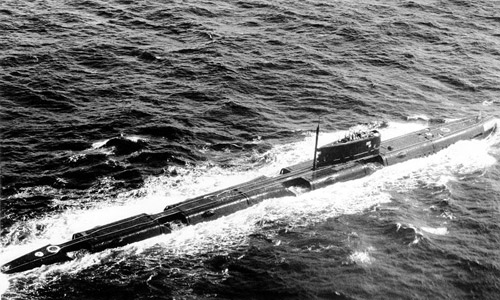Echo-class
Summary
| Origin country | 🇨🇳 Ex-USSR |
| Category | Submarine |
| Subtype | Nuclear missile submarine |
| Manufacturer | Komsomolsk-on-Amur, shipyard No. 199, Severodvinsk, shipyard No. 402 |
| Year commissioned | 1960 |
| Units | K-45, K-59, K-66, K-122, K-151 (ECHO I), K-1, K-7, K-10, K-22, K-23, K-28, K-31, K-34, K-35, K-47, K-48, K-56, K-57, K-74, K-90, K-94, K-104, K-108, K-116, K-125, K-128, K-131, K-135, K-166, K-170, K-172, K-175, K-184, K-189 (ECHO II) |
Description
The Echo class were a series of nuclear-powered cruise missile submarines built by the Soviet Navy in the 1960s. These submarines could be classified into two different projects based on their configurations and capabilities: Project 659, known as Echo I, and Project 675, referred to as Echo II.
The Echo I class submarines were constructed at Komsomolsk in the Soviet Far East between 1960 and 1963. These were initially equipped with six launchers for the P-5 Pyatyorka land-attack cruise missiles. Designed to operate in a strategic role, the Echo I class lacked the necessary fire control and guidance radars for engaging enemy ships. With the expansion of the Soviet SSBN force, the role of Echo I class shifted, leading to their conversion into Project 659T attack submarines between 1969 and 1974. This involved removing the cruise missiles, streamlining the hull, and updating sonar systems to reduce noise and improve stealth. The entirety of the Echo I class was stationed with the Pacific Fleet until their last scrapping in the early 1990s.
The improvement came with the Echo II class, developed between 1962 and 1967, which comprised 18 vessels from Severodvinsk and 11 from Komsomolsk. Designed as anti-carrier assets, Echo II class vessels were equipped with eight P-6 anti-ship cruise missiles. Unlike the previous class, the Echo II had the ability to fire all eight missiles in roughly 30 minutes. However, they also required surfacing during the launch sequence, which exposed them to detection and attack.
Enhancements ensued in the mid-1970s when fourteen Echo II submarines underwent conversions to carry the more advanced P-500 Bazalt cruise missile, detectable via bulges added to the edges of the sail. Further improvements led to three units being upgraded to carry the even faster and longer-range P-1000 Vulkan missile toward the end of the Cold War. These were part of the Northern Fleet, while two Pacific Fleet boats had their upgrades halted due to funding issues.
The Echo II submarines had an operational split between the Pacific and Northern Fleets. They were deemed outdated by the mid-1980s, which signaled the start of their decommissioning, completed between 1989 and 1995.
The operational history of the Echo class is marred by numerous accidents. Among them are collisions with other military and civilian vessels, fires onboard resulting in fatalities, and nuclear reactor accidents leading to radiation exposure and contamination. These incidents underscored the risks inherent in submarine operations during the Cold War period.
Technical specifications
| Displacement | 3828 tons |
| Displacement submerged | 4999 tons |
| Range | 48000 km |
| Endurance | 50 days |
| Crew | 104 members |
| Width | 9.2 m (30.2 ft) |
| Length | 111.2 m (364.8 ft) |
| Max. depth | 300 m (984.3 ft) |
| Propulsion | 2 pressurized water reactors with a power of 70,000 hp each - 2 propellers |
| Armament | 6 SS-N-3A Shaddock antiship missiles + 4 533mm TLT + 4 406mm TLT |
| Maximum speed | 15 knots |
| Max. speed submerged | 24 knots |

